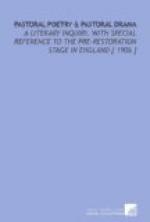The, eclogues, twelve in number, appear to have been mostly composed about the middle of the fourteenth century. In the days of Petrarch the art of Latin verse was yet far from the perfection it attained in those of Poliziano and Vida; it was a clumsy vehicle in comparison with the vulgar tongue, which he affected to despise while setting therein the standard for future ages. Nevertheless, Petrarch’s Latin poems bear witness to the natural genius for composition and expression to which we owe the Canzoniere. The editio princeps of the pastorals appeared in the form of a beautifully printed folio at Cologne in 1473, ninety-nine years after the poet’s death. They were entitled Eglogae[26] (i.e. aeglogae), by which, as Dr. Johnson remarked, Petrarch, finding no appropriate meaning in the form eclogae, ’meant to express the talk of goatherds, though it will only mean the talk of goats.’
No two men ever won for themselves more diverse literary reputations than Petrarch and his friend Boccaccio. The Latin eclogue is one of their few points of literary contact. The bucolic collections contain no less than sixteen such poems from the pen of the younger writer[27], which, though not devoid of merit as poetical exercises, show that as a metrist Boccaccio fell almost as far short of his friend in the learned as in the vulgar tongue. They were composed at various dates, mostly, it would appear, after 1360, though some are certainly earlier; and it would be difficult to say whether to him or to Petrarch belonged the honour of reviving the form, were it not that, both in the poems themselves and in his correspondance, he explicitly mentions Petrarch as his master in the kind[28]. In any case the dates of composition must cover a wide period, for the poems reflect varions phases of his life. ’Le Egloghe del Boccaccio,’ says an Italian critic, ’rappresentano tutta la vita psicologica del poeta, dalle febbri d’amore alle febbri ascetiche.’ The amorous eclogues, to which in later life Boccaccio attached little importance, are early; several are historical in subject and are probably of later date, though one may be as early as 1348; there are others of a religions nature which belong to the author’s later years. The allusions in these poems are so obscure that it would in most cases be hopeless to seek to unravel the meaning had not the author left us a key in a letter to Martino da Signa, prior of the Augustinians. Many of the subjects are purely conventional, such as those of the early poems on the loves of the shepherds, the historical panegyrics and laments, and the satire on rich misers. The same may be said of a dispute on the respective merits of poetry and commerce, and of a poem in praise of poetry; although the former has an obvious relation to the author’s own circumstances, and the latter appears to be inspired by genuine enthusiasm and love of art. The forces of confusion that have dogged the pastoral in all ages show themselves




